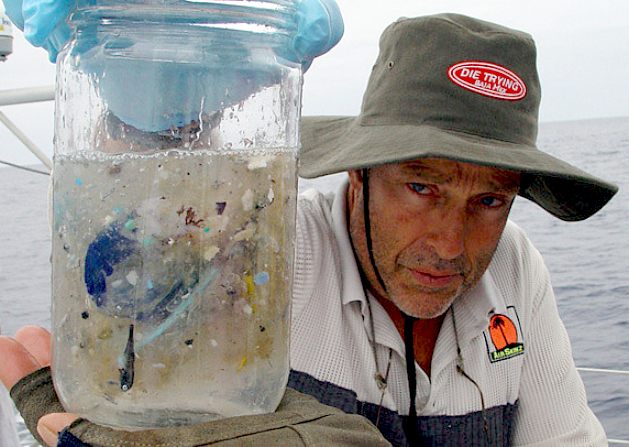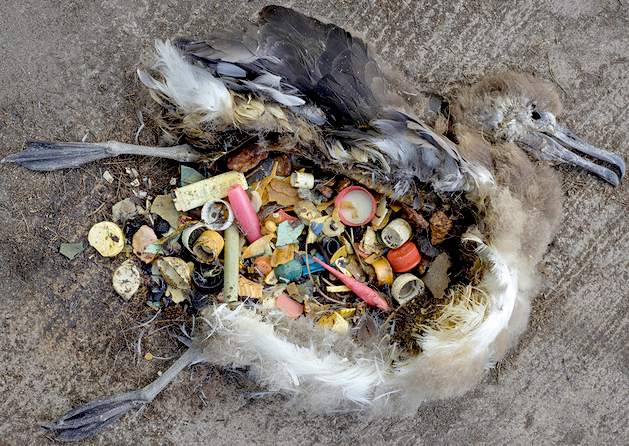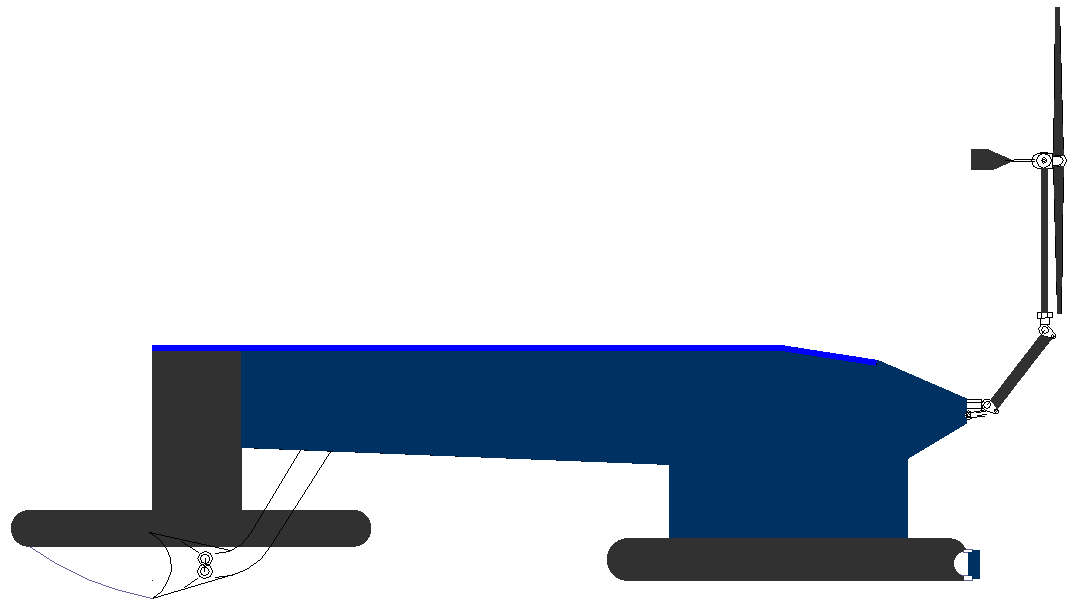|
THE GREAT NORTH PACIFIC GARBAGE PATCH
|
|||||||||||||||||||||||||||||||||||||||||||||||||||||||||||||||||||||||||||||||||
|
This world map is derived from an Oceanic illustration of the six main gyres that we should concentrate on if we are to stand any chance of reducing plastic waste to acceptable levels. The North Pacific gyres (West and East) is just one area of several swirling trash zones (gyres) in our oceans, and it's where a lot of our plastic litter ends up. While these debris patches aren't visible piles of floating trash in the water, they are inverted mountains - a bit like landfill sites at sea - hidden from view. The reality of what they are and how they got there is mind boggling and extremely harmful to marine life. We can't (at the moment) do much about nuclear waste in the oceans (except appeal to reason), but we can act to vacuum up solids. The technology exists, we should use it.
You've
probably heard of the 'Great Pacific Garbage Patch,' and thought "blo_*/%
heck, what a c*%@ up. Where's Superman
when you need him. Beginning
Solving the problems of marine debris and plastic pollution is a perfect example of the need to think globally and act locally. The emphasis is on the word 'act', but there is a distinct lack of action.
Let’s take as an example the ubiquitous plastic water (PET) bottle bought from a convenience store, or by the case (wrapped in more plastic (polythene), of course). When you are done with it, you put it in the recycling bin – but what if the bottle never gets to the recycling plant? It could easily blow or wash into a nearby stream or river instead, especially if it goes into a storm drain (water through storm drains is not treated at wastewater treatment plants, so all trash that goes into them goes into the watershed and ultimately out to the ocean). The figures tell us just how casual landlubbers are, not that seafarers are any more careful.
Along the way, sun and water may break the plastic bottle into smaller and smaller plastic pieces, but it will not degrade entirely. If this plastic bottle began in California, the chances that its plastic bits - are now in the large ocean currents that contribute to the North Pacific gyre - spread over a wide area.
A gyre is any vortex in
air or water, but the word is most commonly used to refer to natural convergence zones of ocean currents that rotate because of the Coriolis Effect. There are gyres in the five major ocean basins - North Atlantic, South Atlantic, Indian, South Pacific and North Pacific. These gyres are not fixed areas; they shift depending on wind, waves, and currents. Scientists are actively studying the gyres, and how they tend to concentrate marine debris.
That is useful for when the ships finally get out there to clean it up,
but study alone will accomplish nothing, save documenting man's downfall.
Plastic particles floating in the ocean can also be small platforms to transport environmental pollutants and invasive species throughout the sea.
ALGALITA: CHARLES MOORE - Most of the plastic stew is made up of smaller bits. These are potentially the most damaging and should be taken out of circulation as a priority. Larger bottles and drums cannot be ingested until broken down to bird and fish size bites. The fish and birds die, but the plastic is then eaten by another animal. It does not go away. Nature has not evolved a way to deal with human waste. It is up to us to put right the mess that we have created.
What's
for lunch mum? The Eastern Garbage Patch is a large gyre of marine debris located near the Midway Islands in the Pacific Ocean.
Albatrosses in the area give birth to 500,000 chicks every year, and nearly half of them
die – many of them after consuming plastic fed to them by their parents, who think it’s food.
PLASTIC POLLUTION FACTS
1. In the Los Angeles area, 10 metric tons of plastic
are carried into the Pacific Ocean every day.
WHO MAKES ALL THIS PLASTIC?
Plastic comes from oil after chemical refining and oil comes from petroleum companies. The companies producing the most polymers and polyolefins, or plastic products derived from such oil derivates are:
They feed thousands more companies who in turn provide drinks bottles and other packaging to shops and supermarkets where you buy products and finally dispose of the single use plastic. This would not be a problem if there was an ocean safety net, but there is not as yet. Hence, we need to lobby politicians to make the money available for effective recycling on land and from the sea.
ACIDIFICATION - ADRIATIC - ARCTIC - ATLANTIC - BALTIC - BERING - CARIBBEAN - CORAL - EAST CHINA
ENGLISH CH - GOC - GULF MEXICO - INDIAN - MEDITERRANEAN - NORTH SEA - PACIFIC - PERSIAN GULF - RED SEA
SEA
JAPAN
- STH
CHINA - PLASTIC
- PLANKTON - PLASTIC
OCEANS - SEA
LEVEL RISE
LINKS & REFERENCE
There's
More Than One Ocean Trash Gyre! 5 Gyres Project Switches... treehugger.com›clean…ocean-trash-gyre-5…video.html
5
Gyres of Plastic Trash Pollutes the World's Oceans » EcoWatch ecowatch.com›2014/04/21/5-gyres…trash…oceans/
Plastic
pollution accumulates in oceanic gyres 5gyres.org›see_global_research/
socialphy.com›posts/off-topic/14979/5-Gyres.html
Garbage
Patch Primer: What's an Ocean Gyre? : Discovery News news.discovery.com›earth/oceans…patch…ocean-gyre…
Ocean
junk is largely concentrated in five ocean gyres cbc.ca›news/technology…mh370…ocean-trash-1.2594539
5
Gyres: Plastic in the World’s Oceans electrolux.pl›sv/Innovation/Campaigns/Vac…5-Gyres/
lefitness.com.br›erro/trash-gyre-ocean
Gyres
Definition. Crossword Dictionary. | ocean basin
model png
klettertechnik-bauservice.de›2/gyres-of-trash
Philippines - A lad is looking for items to recycle
Inhabitat 19 year old student develops cleanup array to remove 7250000 tons plastic-from worlds oceans The mind unleashed author Tmuorg Plastic
Boards 5 Gyres - Understanding Plastic Marine Pollution Wind Driven Surface Currents: Gyres SIO 210: Introduction to Physical Oceanography - Global circulation SIO 210: Introduction to Physical Oceanography - Wind-forced circulation notes SIO 210: Introduction to Physical Oceanography - Lecture 6 Physical Geography - Surface and Subsurface Ocean Currents North Pacific Gyre Oscillation — Georgia Institute of Technology Education National Geographic ocean gyre National Geographic 2014 July ocean-plastic-debris-trash-pacific-garbage-patch Plastic Soup News Blogspot 2014_July Un package me.whats wrong with plastic Neuro research project 2013 death-by-plastic Indiegogo projects sailing the Atlantic ocean to study plastic pollution http://ecowatch.com/2014/04/07/22-facts-plastic-pollution-10-things-can-do-about-it/ http://ecowatch.com/2014/04/07/22-facts-plastic-pollution-10-things-can-do-about-it/ http://www.lastnightsgarbage.com/?cat=56 https://www.indiegogo.com/projects/sailing-the-atlantic-ocean-to-study-plastic-pollution http://unpackageme.com/whats-wrong-with-plastic/ http://neuroresearchproject.com/2013/02/21/death-by-plastic/ http://www.worldwildlife.org/threats/pollution http://plasticsoupnews.blogspot.co.uk/2014_07_01_archive.html http://en.wikipedia.org/wiki/Marine_debris http://www.plasticoceans.net/the-foundation/ http://www.greatrecovery.org.uk/plastic-its-a-lovehate-thing/ http://www.greatrecovery.org.uk/ http://www.epsrc.ac.uk/ http://themindunleashed.org/author/tmuorg http://seaplexscience.com/ http://abundantseas.org/ http://www.gyrecleanup.org/cleanup-plan/ http://education.nationalgeographic.co.uk/education/encyclopedia/ocean-gyre/?ar_a=1 http://www.plasticboards.com
PATENT PENDING - A non-polluting vessel such as the SeaVax concept above could be an ideal base engine when it comes to filtering garbage from the world's ocean gyres. The SeaVax is based on patent Bluefish ZCC technology. These zero carbon cruisers are robotic ocean powerhouses. The proposed design uses no diesel fuel to cruise the oceans autonomously (COLREGS compliant) 24/7 and 365 days a year as required. With such awesome power generating capability, a solar and wind powered ZCC can be adapted to extract plastic waste from ocean garbage patches. Several of these cleaners operating as Atlantic, Indian and Pacific ocean fleets could make such conservation measures cost effective, and even potentially financially attractive to governments around the world - for the health of the world. Recovered plastic could be processed to produce oil, energy or recycled products. Better than letting fish and seabirds eat the waste and kill themselves, and who knows how that may affect us, where seafood is an essential resource for mankind.
|
|||||||||||||||||||||||||||||||||||||||||||||||||||||||||||||||||||||||||||||||||
|
This
website is Copyright © 2024 Bluebird Marine Systems Limited.
The names Bluebird™, Bluefish™,
SeaNet™,
SeaVax™
and the blue bird in flight
|



